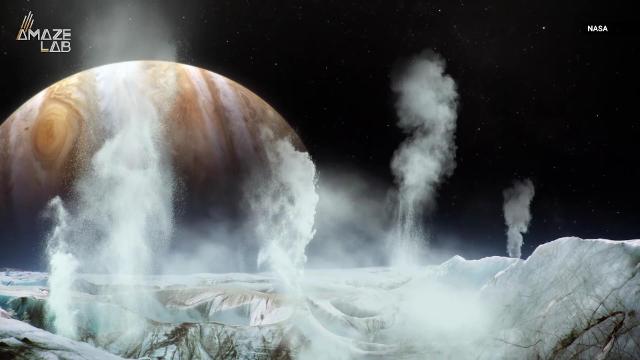
This robot may help find alien life on Jupiter's moon Europa
Essentially, the bot would drill down through the ice and would test it as well as the water at the ice-water interface.
Buzz60
How did we arrive on the surface of this planet? Are we the product of a cosmic chemical casualty, or something brought us here? Will we be here forever?
For centuries, human thought has been interested in solving these questions, understanding the universe, the origins of life on Earth, and whether there is more life throughout the cosmos. Hundreds of telescopes have been built around the world (and others sent into space!) to be able to observe more details in the universe. In order to understand what the ideal conditions are to allow for advanced life, we must first study the conditions on our planet, and then look for similar patterns in our solar system. Little by little, today's technology enables us to discover more details that have been previously inaccessible.
Our planet has a diameter of around 7,930 miles; it is a rocky world with oceans, clouds, an atmosphere composed of gases such as nitrogen, carbon dioxide, oxygen, methane, and a surface composition of heavy elements, like silicon and iron. The temperature of the Earth permits the existence of liquid water on its surface. The interior contains a core: the very center of our planet is a hard sphere of iron and nickel. Above the core there exists a lighter layer, known as the mantle, composed of silicon and oxygen, and then an even lighter layer, called the crust, containing granite and basalt. Finally, one finds the most external layer of cool and rigid rock, named lithosphere.
The Earth has one natural satellite, the moon, which protects us from impacts of small rocks like asteroids and comets. Our planet's internal heat, mostly from the radioactive decay of heavy elements, drives geological activity. The Earth also produces a magnetic field that protect us from dangerous, highly energetic charged particles that emanate from the sun. The interaction of these particles with Earth’s magnetic field creates the beautiful auroras that periodically adorn the winter skies of northern and southern earthlings.
After the formation of the Earth around 4.5 billion years ago, life arose very quickly, around 3.85 billion years ago, essentially right after the planet cooled down sufficiently. In other words, when life could arise, it did. The oldest fossils show that bacteria-like organisms were present on Earth 3.5 billion years ago. Life evolves in time through natural selection and mutations. Cyanobacterias start releasing oxygen about 3.5 billion years ago and all that oxygen built up to a major component in Earth’s atmosphere about 2 billion years ago. From 540 to 500 million years ago, a dramatic diversification of life happened — an event scientists call “the Cambrian Explosion.” And around 225 to 65 million years ago dinosaurs and small mammals populated the surface.
Studies suggest that the earliest life on Earth may have resembled today’s bacteria found near deep ocean volcanic vents and geothermal hot springs. We recently found out that some microbes can survive years in space; in fact, dozens of microbial species may have accompanied the Curiosity rover to Mars, where it landed in August 2012. Maybe we have already sent the seeds of new life over there.
The necessities of life as we currently understand it are nutrients, energy and liquid water. Are these easily found elsewhere, or only on Earth? Comparing the different celestial bodies in our solar system, there is an important point to consider: planets close to the sun are too hot for liquid water, and planets far from the sun are too cold for liquid water. The ideal planet for advanced life should exist in the “habitable zone” — neither too far nor too close from the sun. Yet, other sources of energy can keep water liquid under a cap of ice even on a frigid moon of a distant planet.
Research about our solar system has found a few candidates to host life: Saturn's moon Enceladus, Saturn’s moon Titan, Mars and Jupiter's moon Europa. Can we find life, or even ancient fossils, like the ones we find on our planet?
We do not know all the answers to our questions, but if human nature made us explorers, and we keep this instinct alive, we can expect to do some fascinating planet-hopping in the near future. NASA is sending the Europa Clipper later this decade, the first spacecraft of a fleet for a comprehensive exploration of Europa. We can only hope that this moment in human history can happen in our lifetime, where life elsewhere in the solar system is finally discovered.
lhuiyolitzin Villicana Pedraza, PhD., is a molecular spectroscopy specialist and on the astronomy and physics faculty at Doña Ana Community College and New Mexico State University.
More Star News:
Staring at the sun: NMSU tracks solar flares, which can do serious damage to telecommunications
When black holes are the brightest thing around
Astronomical Christmas gift: The James Webb Space Telescope
https://www.lcsun-news.com/story/life/2022/04/02/what-look-when-searching-life-other-planets/7226370001/
2022-04-02 13:23:14Z
CAIiEDKZeQxRTDQBuchRNk2Mpz0qGQgEKhAIACoHCAow15GACzCe6YsDMN_p9wU
Bagikan Berita Ini















0 Response to "What to look for when searching for life on other planets - Las Cruces Sun-News"
Post a Comment